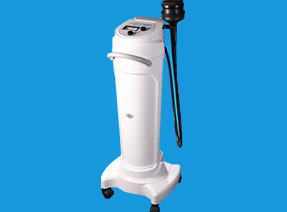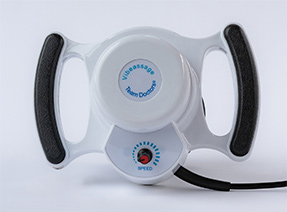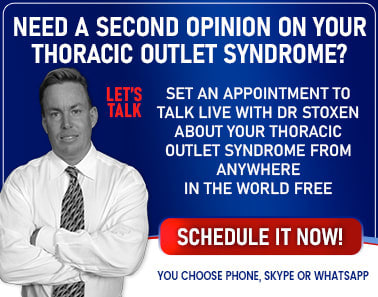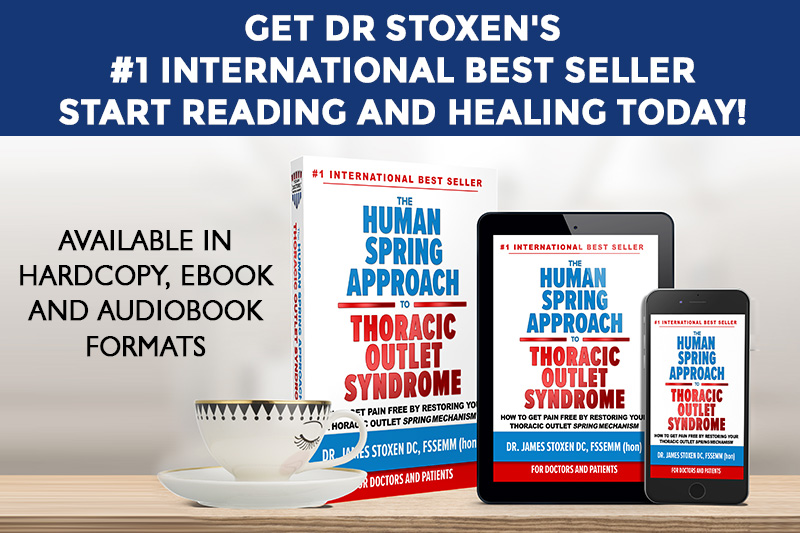THE HUMAN SPRING APPROACH TO
THORACIC OUTLET SYNDROME
by Dr James Stoxen DC., FSSEMM (hon) FWSSEM
SAMPLE CHAPTER
INTRODUCTION
Are you sick of the pain?
Introduction
Still wondering why the pain won’t go away?
Tired of doctors’ promises ending in failure?
You aren’t alone. “The standard-of-care approaches used by my doctors didn’t work for me.”
I know the treatment approaches used by your doctors aren’t working for you, because they’re not working for anyone!
Not only that, but these same exam and treatment approaches used for headaches, herniated discs, chronic pain, chronic fatigue, and fibromyalgia don’t work for these conditions either.
It is because they are all based on a flawed model of biomechanics that doesn’t even abide by the laws of physics and nature. This means they’ll never work, no matter how many treatments you get. Period.
I know, that’s some pretty strong language . . . but after you read this book, you will know I’m right and know why I’m right.
I had an epiphany after my arduous struggle that led to this revelation . . .
If you ask the thousands of doctors around the world who’ve evaluated my human spring approach, they will agree it is the only approach that makes sense.
This book offers an ultimate examination and treatment approach for reversing thoracic outlet syndrome.
In this book, you will learn my new way to study, examine, and treat the human body, which is an advancement that I predict will forever change the way medicine is practiced. It will reshape your fitness and lifestyle choices.
It can help bring relief to the millions around the world who suffer from chronic pain. It will improve your personal performances in sports and leisure activities and prevent accelerated aging.
How Did It Get Discovered?
When I was injured, numerous doctors examined me and used the standard-of-care protocols for examining patients with neck pain, back pain, and shoulder pain. Why did all their exam approaches fail to arrive at the correct diagnosis of thoracic outlet syndrome?
Even with the many diagnoses not one doctor who used the standard-of-care protocols could explain the cause of my pain. These doctors treated me with traditional approaches, but I got no relief from my neck pain, back pain, and shoulder pain.
At 27 years of age, I was faced with a severe case of chronic thoracic outlet syndrome, symptoms of chronic fatigue syndrome, fibromyalgia, stress, and was depressed every day with no hope of a cure.
Why do all these treatments fail? My mother always said if something doesn’t make sense, keep asking questions until you find the answers. I knew something big had to be missing. I believed in my body’s natural healing abilities, but something was interfering with that restorative process. I needed to know what that was!
So, I reconsidered human engineering from an entirely different, more logical point of view. I took off my white coat and considered the human form from different, logical points of view: a mechanical engineer, an anatomist, and a physicist. I then combined this new perspective with my years of experience interviewing top sports scientists and coaches, as well as consulting, examining, treating, and training hundreds of elite athletes in many sports from around the world.
So much is misunderstood about the way the human form really works, more specifically, how it moves. The current way people are examined and treated is based on a 340-year-old model of human movement that says the body moves as a series of levers.
It does move as a series of levers.
However, there are four functions that the “lever series model” cannot explain, so they become mysteries doctors have difficulty understanding.
Mystery 1—How does the body absorbs impacts?
Currently doctors and scientists think it is impossible for a body designed as a lever to absorb the impacts of walking and running without injury. That is why they recommend cushioned running shoes.
How do they explain millions of people around the world running barefoot and actually having less arthritis and aging than those who wear shoes? I became a barefoot runner after making this discovery.
Mystery 2—How does the body recycle energy to prevent early and chronic fatigue?
Doctors know lever mechanisms push with muscles, which burn a lot of energy. With this current method of thinking, it’s impossible for people to run a marathon without running out of energy. How do they do it then?
Mystery 3—How does the body maintain the healthy spaces for joints?
Levers cannot be engineered to open joint spaces. How does the body maintain these joint spaces?
Mystery 4—How does the body provide spaces for the safe passage of blood vessels and nerves? (For example, carpal tunnel syndrome, herniated discs, thoracic outlet syndrome, and many other conditions caused by compression.)
It’s impossible to open spaces for nerves and blood vessels with lever engineering. What is the engineering of the thoracic outlet and tunnel?
The body does accomplish certain tasks with levers, but the above four functions cannot be explained with levers. So why do doctors examine us by checking our lever movements?
The reason why you have been misdiagnosed and mistreated is because they are examining and treating you as a lever mechanism when your body is really designed as a spring.
Makes sense, doesn’t it? How could so many doctors miss this?
In the past 15 years, I have been invited to present this new model of human engineering at more than 55 medical conferences attended by medical physicians and scientists from more than 60 nations
In 2014, I was invited to speak at the World Congress in Sports and Exercise Medicine in Kuala Lumpur, Malaysia. There were nearly 100 international and local leaders fielded as speakers for the congress. You might be shocked that medical physicians would invite a chiropractor to address elite medical physicians from more than 35 nations.
This was a unique opportunity for the global sports and exercise medicine community to learn this new model and approach that I developed.
In this lecture, I presented strong scientific proof that the current model that explains how the body moves and what all the standard-of-care treatment approaches are currently do not abide by the laws of physics and nature.
In a sense, I presented proof that by using the current standard-of-care model and approach, it was impossible to get complete restoration of the human body, because the diagnoses were based on flawed models.
Can you guess how these physicians responded to this chiropractor?
The accreditation committee recommended I receive the conferment of honorary fellowship for my distinguished research and contributions to the advancement of sports and exercise medicine on an international level.

Dr. James Stoxen DC., FSSEMM (hon) (right) is awarded an honorary fellowship
by a member of the royal family, the Sultan of Pahang (left).
On November 5, 2015, I was honored with the honorary fellowship by a member of the royal family, the Sultan of Pahang, at the opening ceremonies of the World Congress in Sports and Exercise Medicine. How did a chiropractor get honored by a multination committee of MD’s who are themselves at the top of their respected fields?
Unfortunately, the majority of the world still doesn’t regard the body as a living spring. Consequently, people are missing out on the most important aspects of how the human body functions in a world governed by the laws of nature, the laws of physics, and common sense.
I have presented every aspect of this new model and approach at more than 50 medical conferences, organized principally by medical doctors, in China, Japan, United Kingdom, Germany, Monaco, Malaysia, Indonesia, Russia, Australia, Brazil, Spain, Thailand, Mexico, Colombia, South Africa, the Philippines, and throughout the United States.
It is estimated that more than 50,000 doctors have attended my lectures, and none of them refuted the science. The global medical community is praising this discovery.
The fact that I am a chiropractor addressing the world’s medical elite at major teaching institutions, hospitals, and associations is something I’m extremely proud of. I cannot tell you how many times I have stepped off the stage and heard someone ask, “How can I find out more about this new model and approach? Do you have a book I can read?”
Well, here is the first book.
What you are about to learn is that you are suffering needlessly, and it’s all because you follow the advice of professionals who embrace an approach to medicine that is outdated and illogical. Because of this, it’s impossible for doctors to determine and treat the root cause of your pain. In fact, they might be causing you to get worse!
The key discovery I made is that these four functions can only be performed if you understand the body as a miraculous spring mechanism.
Once you learn how it works, the important functions it serves, how it breaks down and locks, and how it affects so many aspects of your health, you will see why so many individuals suffer and are misdiagnosed and mistreated.
Then, when I teach you my new approach to releasing the compression on your thoracic outlet and how to strengthen the spring mechanism, you will understand why my patients recover from thoracic outlet syndrome quickly and at maximum medical improvement, while other approaches have failed.
In this book, I will teach you the new integrated spring model and apply it to the examination and treatment of your thoracic outlet syndrome.
Ready for the “aha” moment?
What Is Thoracic Outlet Syndrome?
If you don’t know what thoracic outlet syndrome is, you are not alone.
In 2017, more than 74,000 people each month were searching on Google for answers to thoracic outlet syndrome. If you combine all the search engines, more than 1,000,000 people per year are searching for answers to thoracic outlet syndrome. One reason why many people are searching for information about thoracic outlet syndrome is because it is a controversial disorder in medicine.
In fact, one author described thoracic outlet compression syndrome (TOCS), as one of the most controversial subjects in medicine. It may also be the most underrated, overlooked, misdiagnosed, and probably the most important and difficult to manage peripheral nerve compression in the upper extremity. (1)
Besides misdiagnosed, some think that it is under diagnosed (2). Some doctors say it’s over diagnosed (3) (4). In my opinion, most doctors just can’t diagnose it.
So many people suffer in pain for weeks, months, and even years, and then someone finally asks,
“Could it be thoracic outlet syndrome?”
Why do so many patients with thoracic outlet syndrome get misdiagnosed?
When it comes to the thoracic outlet syndrome diagnosis, the exact criteria about how to diagnose it are not well defined, even by experts. Putting it bluntly, the majority of doctors are really confused about thoracic outlet syndrome! What is scary is that they don’t really know the cause of thoracic outlet syndrome!
In order to do a quality examination that leads to the correct diagnosis, your doctor must know the anatomy of the thoracic outlet.
Here’s the problem! For nearly 30 years, there has been discussion of the decline in undergraduate knowledge of anatomy among the surgical community (5) (6) (7) (8) (9). In the studies that have been conducted, they suggest that the knowledge of the qualifying doctor is now below an acceptable level (10) (11) (12).
If the cause of TOS is compression of the outlet and tunnel, it’s absolutely necessary for doctors to understand that the outlet is engineered to perform these four amazing functions. This is called biomechanics.
Here is an example of how the medical profession doesn’t really understand the engineering of the thoracic outlet area.
The shoulder is the roof of the thoracic outlet and tunnel. If it drops down into the tunnel, it can compress the blood vessels and nerves.
I have done extensive online searches; searched the massive National Institutes of Health (NIH); and read thousands of books, magazine articles, and research studies to find an explanation for how the shoulder is suspended over the outlet and tunnel. This is extremely important to know to treat patients with thoracic outlet syndrome.
I found nothing! Go ahead and do an NIH, PubMed, or online search.
It is impossible to explain how the shoulder suspends itself over the thoracic tunnel understanding that the body is designed as a series of levers. That is why there is no explanation for how the shoulder is suspended over the outlet.
If there is no information available for doctors to understand how the roof of the outlet and tunnel is engineered, then how can they re-engineer it to open?
This is why I had to determine the correct engineering of the body, because it was not available anywhere in medicine.
I dare you to ask the top 10 engineers and physicists in the world this question.
“Could you please tell us how the human body is engineered to allow safe passage of blood vessels and nerves though the thoracic tunnel with levers?”
Doctors and scientists cannot explain the design or engineering of the thoracic outlet with lever engineering. That is because it is designed as a spring suspension mechanism.
I dare you to ask the top 10 engineers and physicists in the world this question.
Could you please tell us how the human body is engineered to allow us to take 270,000,000 collisions with Earth (steps) without causing damage to the joints with levers?
This can’t be explained by traditional knowledge, because the human body is not designed as a lever series, but as a spring mechanism!
My Discovery—The Human Spring Approach
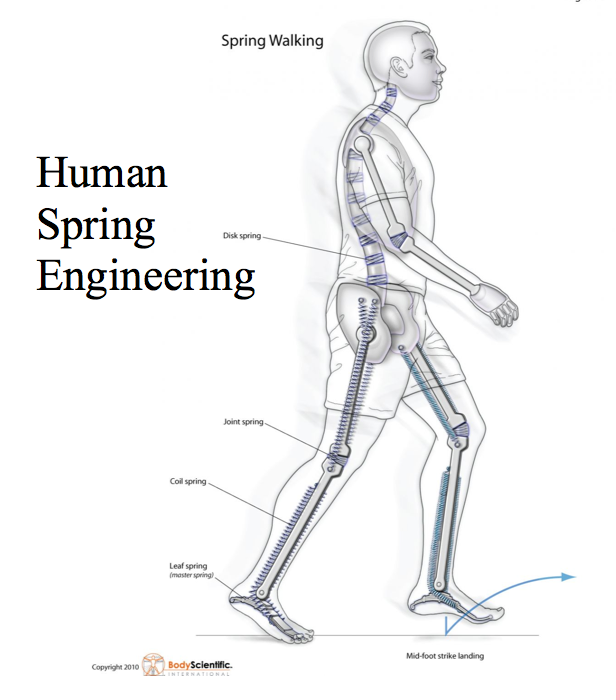
The Integrated Spring-Mass Model
The concept that is most misunderstood is that the body is not only a system of levers but also an integrated spring!
It’s a new model that will help you finally understand the mysteries of why the body breaks down, doesn’t heal, and degenerates into a chronic pain state of suffering.
Chapter 1, “What Is Thoracic Outlet Syndrome?” reveals that TOS is caused by compression of the outlet or tunnel where the blood vessels and nerves pass from the neck or the thorax to the arm. What is causing the compression?
If you and your doctor know the cause of the compression and know how to reverse it, you can end your suffering. Understanding this concept prevents surgery in just about every patient with TOS.
To understand this, you need to have extensive knowledge of three things:
- Thoracic outlet anatomy
- Which muscles keep the thoracic outlet and tunnel open and which close it down
- How tension is controlled in those muscles
In this chapter, I discuss exactly what thoracic outlet syndrome is and provide an extensive review of the thoracic outlet anatomy.
Included in this chapter are custom illustrations of a normal thoracic outlet and the abnormally compressed thoracic outlet. After looking at these illustrations, I guarantee you are going to better understand thoracic outlet syndrome and the other conditions associated with this area of the body.
Chapter 2, “A Painful Misunderstanding of Human Engineering,” I present the 340-year-old model of human engineering that doctors and other healers base their approach to examining and treating you Then I present a model of human movement proposed by Harvard University scientists that better explains how the body absorbs impacts and recycles energy. Then I present an advancement of the model proposed by Harvard University scientists I nicknamed the human spring model.
The Human Spring Model not only explains how the body absorbs impacts, recycles energy and opens spaces for joints it also eloquently explains how the human spring engineering provides a safe passage for blood vessels and nerves through the thoracic outlet or thoracic tunnel.
I present logical, easy-to-understand arguments why my model of biomechanics is the only model that explains how human bodies perform these important functions.
- How does the body absorb collisions with Earth during walking and running? A spring off the ground better protects the joints from painful arthritic conditions than a bang and a twist with a rigid lever.
- How does the body recycle energy to prevent chronic fatigue? A spring off the ground with elastic elements can recycle more energy than a bang and a twist with a rigid lever.
- How does the body open spaces for joints, such as the ankles, the knees, and the hips? A spring can open spaces for knees where the body cannot open spaces with a lever mechanism.
- How does the body open spaces and tunnels for the safe passage of blood vessels and nerves? Springs and spring-suspension engineering can suspend the shoulder over the thoracic outlet and tunnel. It’s impossible to open a tunnel between the shoulder and the chest to let blood vessels and nerves pass safely into the arm with human levers.
You will learn that this lever-series model cannot explain these important functions the body must do and, in fact, it does not even abide by the laws of nature and physics. I will present scientific fact that proves the human body uses spring engineering to complete these four tasks.
When I’m done, you will agree that my human spring model is more logical and it must replace the old, outdated, and wrong lever-series model. Don’t worry, doctors around the world agree with me, so there should not be any arguments about this.
Chapter 3, “Human Spring Engineering,” explains thoroughly, in simple terms, how looking at the human body as a spring is a more comprehensive and logical model for understanding how the body works according to the laws of physics and nature.
Looking at the human body modeled as a spring allows you to fill the gap of what is misunderstood about the human body. It gives you an approach that is well-researched, sound in principle, and, best of all, delivers optimum results.
Chapter 4, “The Control of Tension on Your Human Spring,” I discuss how we can make changes in the tension of our body’s spring as a part of everyday life. When you step off a curb, you know exactly the amount of tension to have a safe landing. Gymnasts know exactly how much tension to have on their bodies for a safe landing. Jogging is different from sprinting, only by the level of tension in the lower body spring.
This change in tension is considered normal and essential to live in harmony with Earth’s gravity. How does this apply to your thoracic outlet syndrome?
Chapter 5, “The Cause of Compression!” discusses the difficulties that doctors have in diagnosing causes of TOS.
The Mayo Clinic, the Cleveland Clinic, and the National Institute of Neurological Disorders and Stroke, plus top-10 ranked hospitals for neurology and neurosurgery tell us that compression is what leads to thoracic outlet syndrome.
However, this spring tension can get out of your control. This happens when reflexes in the brain take over and dominate the tension, putting you in an abnormally compressed state of pain and suffering.
Therefore, how this tension is controlled by reflexes is extremely important for the understanding of the cause of thoracic outlet syndrome, herniated discs, headaches, and many other painful conditions caused by compression.
This was the “aha” moment that determined what was getting in the way of the healing process. Understanding that tension creates drag on the energy-saving spring system is what explains the cause of chronic fatigue syndrome.
So, if doctors and other healers don’t know how these important parts of the body are engineered and how the tension is controlled that causes the compression then how could they possibly reduce the compression on the outlet and tunnel back to normal?
Chapter 6, “Break These Laws . . . Get Sentenced to a Lifetime of Suffering” lists the most common activities of daily life that violate the laws of physics and nature to put you in disharmony with Earth’s gravity, leading to the cause of compression. When your movements and posture are not in harmony with gravity, your nervous system will react and twist you into a chronic state of suffering.
In this chapter, I present simple rules you must follow in your everyday life to abide by the laws of nature and physics, so your nervous system can remain in harmony with the pull of Earth’s gravity.
Here I educate you on the best sleeping posture, sitting posture, multitasking, and computer use, such as use of the mouse, keyboard, monitor position, and visual stressors. I review the dangers of overuse of your mobile phone, smartphone, remote controls, and other handheld devices. I also review occupational injuries and an instantaneous overloading strain caused by auto accidents and personal injuries.
If you follow these rules and remove these activities that cause a reaction of your nervous system to compress your human spring, a lot of your suffering will be reduced, even without treatment.
Chapter 7, “How Do They Diagnose It?” discusses why it is that so many conservative, nonsurgical treatments fail thoracic outlet syndrome sufferers and all other conditions and disorders caused by compression of your body.
Most important, your road to recovery starts with the doctor’s examination.
Your doctor illogically uses examinations with lever movements to determine why your body’ spring system is compressed. It’s illogical!
In this chapter, I review the only way to determine if your thoracic outlet is compressed and what is compressing it. This requires doctors to touch you all over. Most don’t even touch you where it hurts! Don’t you hate that? When they don’t touch you where it hurts, you begin to become skeptical of their medical opinions, don’t you? I did! Maybe that is why you need to read this book.
I will teach you how you should be examined. I will review the key orthopedic tests and examinations that will uncover the cause of your thoracic outlet compression and your other pain and suffering.
Most important, I will teach you the way to examine yourself. Then you can fire your doctor and treat yourself with the self-treatment I provide in Chapter 13, “What Works and Why.”
Chapter 8, “More Tests?” reviews why most patients think that diagnostic tests might be able to spot thoracic outlet syndrome or a herniated disc.
You’ll understand after reading this book that if doctors tell you they can diagnose thoracic outlet syndrome or most musculoskeletal conditions with a single test, such as an MRI, they are not being truthful.
In fact, the findings on your MRI, that you eagerly await, oftentimes lead your doctor to a wrong diagnosis. This will delay your recovery. What is worse is that it could lead you into unnecessary surgery. Getting cut open to have metal plates screwed into your neck, when you never needed it, will leave you in pain from the surgery, and you will still have same symptoms of thoracic outlet syndrome.
In 2016, I gave a presentation “The Earliest Detection, Intervention and Prevention of Compression Syndromes, TOS, Herniated Discs and Degenerative Joint Disease” at the World Congress of Anti-Aging and Longevity, Mexico City, Mexico.
Did I talk about the latest diagnostic tests? Yes! Here is the scientific study that confused the doctors in the audience.
I presented three individual studies, conducted by Japanese researchers who performed MRI scans on volunteers who were completely pain free. The volunteers had never had pain in their necks or backs in their life.
The researchers found that more than 30 percent of the volunteers had herniated disks that they did not know they had.
Doctors know that with an MRI scan, they have a greater than 30 percent chance of finding a herniated disc. If you had this herniated disc before you had the onset of thoracic outlet syndrome or pinched nerve symptoms, this is not the cause of your pain. But they will probably tell you it is. Are they trying to trick you or do they just not know?
For more than 30 percent of you, the MRI will reveal a herniated disc you had before the onset of pain. That finding of a herniated disc will confuse even a well-meaning doctor. The difference is that now you are face to face with a neurosurgeon.
Again, this huge misunderstanding of the results of MRI scans and other diagnostic tests, can lead to a misdiagnosis, mistreatment, and a lifetime of suffering you don’t need. Because you don’t know fully understand these tests, a doctor can tell you anything and you believe him.
That ends right here and right now.
Chapter 9, “Is It TOS, This, That, or All the Above?” teaches you that patients with thoracic outlet syndrome are the most misdiagnosed, mismanaged, misinformed, and mistreated patients today.
Treatments fail when the treatment is applied to the wrong diagnosis. It is possible that failed attempts at conservative management are related to the wrong diagnosis or in incomplete diagnosis. Keeping it simple, the patient is simply misdiagnosed.
What is even more challenging for you is that the majority of physicians who get the diagnosis right get the cause wrong. Because they don’t treat the cause, even with the right diagnosis the treatment approach is destined to fail.
Many time-strapped doctors today, in all branches of medicine, typically spend 10 to 15 minutes or less with each patient—not because they don’t care, but because there are simply not enough hours in the day to meet the demands for an in-depth examination.
How are doctors supposed to be able to differentiate if you have thoracic outlet syndrome or 30 other conditions that mimic thoracic outlet syndrome? If it’s their area of expertise, it takes an hour to really do a thorough examination.
Here is a list of the 30 different conditions that mimic thoracic outlet syndrome.
- Herniated disc, bulged disc, slipped disc, sixth nerve root
- Herniated disc, bulged disc, slipped disc, seventh nerve root
- Herniated disc, bulged disc, slipped disc, T1 nerve root
- Cervical radiculopathy, brachial plexus injury, or brachial neuritis
- Cervicalspondylosis
- Necktrauma
- Thoracic disc injuries
- Clavicle injuries—acromioclavicular joint injury
- Clavicle fracture malunion
- Inflammatory conditions of the shoulder (tendonitis arthritis)
- Shoulder impingement syndrome
- Rotator cuff inflammation
- Intercostal neuritis (pinched nerve between the ribs)
- Cubital tunnel compression
- Carpal tunnel syndrome
- Guyon’s canal
- Median nerve entrapment
- Double crush
- Triple crush
- Quadruple crush
- Vascular diseases (atherosclerosis)
- Paget-Schroetter syndrome or effort thrombosis
- Pancoast’s tumor
- Spinal cord tumor or neoplasm
- Complex regional pain syndrome (reflex sympathetic dystrophy)
- Degenerative spinal cord disease—MS
- Degenerative spinal cord disease—syringomyelia
- Raynaud’s phenomenon
- Cervical ribs and fibrous bands
- Myofascial pain syndrome
All these conditions mimic the symptoms of thoracic outlet syndrome. So, if you only got that 10–15-minute history and examination, and then the doctor made a diagnosis, or if the treatment approach the doctor is using isn’t getting you the results you expected, you might be misdiagnosed.
Also, what really confuses doctors and patients is that you could be underdiagnosed. What that means is that you were diagnosed with carpal tunnel syndrome, but in reality you have carpal tunnel syndrome, median nerve entrapment, rotator cuff tear, and a thoracic outlet syndrome at the same time.
If it’s not the doctors’ area of expertise, and they don’t know what goes into a thorough exam, you’ll probably get 10 minutes of chitchat. If you don’t know some basic anatomy (for example, how the thoracic outlet is engineered, how you should be examined), then a doctor could simply skim over the exam, never touching the area that hurts, and instead order an MRI scan and a referral to a neurosurgeon.
Do you wish there was a way to fact check your doctor’s diagnosis?
Well, in this chapter, we will review each of the 30 different diagnoses that could be considered with your array of symptoms and give you tips on how you can differentiate between each of them and thoracic outlet syndrome.
Chapter 10, “What Treatment Doesn’t Work and Why?” reviews my exhaustive research of more than 2,500 studies in the U.S. National Library of Medicine, part of the National Institutes of Health database. This is the complete list of treatment procedures and approaches studied for the treatment of thoracic outlet syndrome. I can almost guarantee the treatment approach used by your doctor is on this list.
- Medication: analgesic drug therapy, antidepressants, anticonvulsants, others
- Scalene injection (bupivacaine)
- Nonsteroidal anti-inflammatory drugs (NSAIDS)
- Painkillers for symptom reduction
- Scalene injection (Botox)
- Gentle stretching of the scalenes and pectoralis minor
- Traction
- Nerve gliding
- Ultrasound and muscle stimulation
- Breast reduction—reduction mammoplasty
- Ergonomic corrections
- Correction of the ergonomics of the workstation
- First rib adjustments, alone
- General massage
- Exercise strengthening
- Different bra for breast hypertrophy
Which one do you think, by itself, removes the compression on the outlet?
None of them!
Now do you wonder why you’re not getting better?
I will provide simple and logical explanations of why these 16 treatment approaches, individually, cannot reverse the cause of your thoracic outlet syndrome.
If treatment and training approaches are not compatible with true engineering of the body and are contrary to the laws of physics, that means they are destined to fail. And you know what? Time and time again, they do fail.
Much of the current, standard-of-care treatments, including adjustments, mobilizations, stretching, rehab exercises, injections, medications, and surgeries are destined to fail to achieve true maximum medical improvement, because the removal of the tension on your human spring is not addressed.
Vertebral discs and the thoracic outlet and tunnel are engineered with spring mechanics. Doctors cannot reverse the compression on your body’s spring mechanism with treatment approaches that are only effective on lever mechanisms.
What is logical about a doctor not knowing the engineering of a machine he is paid to fix?
Chapter 11, “When in Doubt, Cut It Out?” will provide additional information about why doctors want to perform surgery for relief of TOS. After enough attempts, of treatments that are designed to treat lever mechanisms, fail to decompress your spring mechanism, you elect to try thoracic outlet syndrome surgery. You tried everything, so, when in doubt, cut it all out, right?
Don’t forget, doctors are magicians. They can cut the pain right out of your body. You can’t think this way!
Because the doctors could not find a conservative approach to relaxing tight scalenes, they cut them out. Because the tight scalenes are causing a raised first rib, compressing the blood vessels and nerves between the first and second rib, they cut your rib out too.
So, do you really still think doctors do surgery because they tried every logical, conservative approach? You would think there is a more logical way to stop the spasms of the muscles and to adjust the ribs down out of the outlet and tunnel rather than cutting them out, right?
Should surgery be a last resort? After reading this book, you will agree that surgery for a compressive disorder, like TOS and herniated discs, are more like a painful misunderstanding of human engineering, than a last resort.
Chapter 12, “Paget-Schroetter Syndrome?” asks, “Is thoracic outlet syndrome dangerous?” If you make mistakes in your game plan to reverse this complex disorder or wait too long, you could be in some real danger.
A blood clot could form in the area of the narrowed vein. If this clot dislodges, it can flow into your lung, causing lung tissue to die, and you end up with difficulty breathing or even death. This is called Paget-Schroetter syndrome.
I review Paget-Schroetter syndrome in-depth, and I commissioned a beautiful illustration that explains Paget-Schroetter syndrome for you perfectly so you “get it.”
Chapter 13, “What Works and Why?” reveals the ONLY two forms of treatments than can effectively reduce the compression that causes thoracic outlet syndrome.
Here I outline the effective treatment for reducing the compression that causes thoracic outlet syndrome. I had a photographer take pictures of a model demonstrating these self-massage and stretching methods that will begin to ease your symptoms and get you on the road to relief.
I also list the most powerful therapy that doctors should be using to quickly reduce inflammation, pain, and the tense muscles that are compressing your thoracic outlet and twisting your frame into a chronic state of suffering.
The reason most doctors aren’t using it is because they can’t get paid by the insurance companies for the treatment. Most doctors don’t do therapies unless they can make a buck.
What is great is that you don’t need to be a doctor to use it, so you can buy it and use it yourself to help you get better without the doctor’s help.
Chapter 14, “Spring Training!” tells you my personal story. Several years ago, my friend and I were in a really bad car accident. The 70-mile-per hour impact into a concrete median totaled her car and caused significant injuries. The accident caused her spinal trauma, an upper back injury, a disc bulge, thoracic outlet syndrome, and the symptoms of mild concussion.
After the accident, I had no pain whatsoever. What?
I had been doing the spring strengthening training listed in Chapter 14 and also barefoot running. So, the reason I did not get hurt was because my “spring training” approach to strengthening the human spring to resist these incredible forces of impact, so it not only rehabilitates, it also protects, therefore, it prevents.
I hired one of the top photographers from Muscle & Fitness and Shape magazines, Bill Dobbins, to shoot color photos of top fitness models, Rachel Moore and Sherry Goggin, demonstrating these exercises and stretches.
I also hired Chicago photographer Stan Magoni to photograph model Gabija Guzauskaite performing the 10 recommended stretches and the exercises we use to open up strengthen the thoracic outlet area of our TOS patients. These photos were taken at the River North Crossfit and at Team Doctors® Rehabilitation and Training Center in Chicago.
There are 30 stretches and exercises for thoracic outlet syndrome designed to widen and strengthen the muscles of your thoracic outlet. These exercises will also help you prevent injuries to your neck in car accidents, work injuries, and sports injuries.
The increased blood flow and strengthening of the muscles of the back, chest, neck, and shoulders greatly improve your posture and help you fight the fatigue from sitting for long sessions at the computer.
Also, I will teach you which thoracic outlet syndrome stretches will make you worse.
Chapter 15, “Conclusion” explains how the odds are against you recovering from thoracic outlet syndrome but with what you learned in this book and my help you will get through this!
This book is about the earliest detection, intervention, and prevention of thoracic outlet syndrome. However, it’s more than just about this condition. In this book, you will learn an entirely new model and approach that helps you understand the mysteries to why the body breaks down, doesn’t heal, and degenerates into a chronic state of suffering.
It also provides many secrets to restoring human performance and preserving the health of the human body. You will learn new ways of thinking about lifestyle choices, exercise, and how your doctors examine and treat you. And it all makes sense, because it follows principles of nature and engineering that are easy to understand.
I strongly feel that the current standard of care must be replaced by examination, treatment, and prevention protocols that are based on the way the universe works. After reading this book, you will realize that the only model of human movement that abides by these laws is the human spring model.
I’m positive you will agree that evaluating and treating you as a human spring is the only way doctors achieve the predictable positive outcomes like we see every day using this model and approach.
I guarantee you that after you read this book you will not allow your doctor to examine and treat you the same way ever again!
Read on to discover more “aha” moments.
CHAPTER REFERENCES
- Atasoy E1 Thoracic outlet compression syndrome. Orthop Clin North Am. 1996 Apr;27(2):265-303. https://www.ncbi.nlm.nih.gov/pubmed/8614579
- Roos DB. Thoracic outlet syndrome is underdiagnosed. Muscle Nerve. 1999 Jan;22(1):126-9; discussion 137-8. http://www.ncbi.nlm.nih.gov/pubmed/9883869
- Wilbourn AJ. Thoracic outlet syndrome is overdiagnosed. Muscle Nerve. 1999 Jan;22(1):130-6; discussion 136-7. http://www.ncbi.nlm.nih.gov/pubmed/9883870
- Wilbourn AJ. Thoracic outlet syndrome is overdiagnosed. Muscle Nerve. 1999 Jan;22(1):130-6; discussion 136-7. http://www.ncbi.nlm.nih.gov/pubmed/9883870/
- Kaufman MH. Anatomy training for surgeons – a personal viewpoint. J R Coll Surg Edinb. 1997;42:215–6. https://www.ncbi.nlm.nih.gov/pubmed/9276550
- Shaffer K. Teaching anatomy in the digital world. N Engl J Med. 2004;351:1279–82. https://www.ncbi.nlm.nih.gov/pubmed/15385652
- Older J. Anatomy: a must for teaching the next generation. Surgeon. 2004;2:79–90. https://www.ncbi.nlm.nih.gov/pubmed/15568432
- The rise and fall of anatomy. BMJ Career Focus. 2005;330:255–6.
- Heylings DJA. Anatomy 1999–2000: the curriculum who teaches it and how. Med Educ. 2002;36:702–10. Full Text Link https://www.ncbi.nlm.nih.gov/pubmed/12191052 Full Text Link https://onlinelibrary.wiley.com/doi/abs/10.1046/j.1365-2923.2002.01272.x
- Waterston SW, StewartI J. Survey of clinicians’ attitudes to the anatomical teaching and knowledge of medical students. Clin Anat. 2005;18:380–4. https://www.ncbi.nlm.nih.gov/pubmed/15971223
- McKeown PP, Heylings DJ, Stevens on M, McKelvey KJ, Nixon JR, McCluskey DR. The impact of curricular change on medical students’ knowledge of anatomy. Med Educ. 2003;37:954–61. https://www.ncbi.nlm.nih.gov/pubmed/14629407
- Prince KJ, Scherpbier AJ, van Mameren H, Drukker J, van der Vleuten CP. Do students have sufficient knowledge of clinical anatomy? Med Educ. 2005;39:326–32. https://www.ncbi.nlm.nih.gov/pubmed/15733169

Meet Dr James Stoxen DC., FSSEMM (hon)
President, Team Doctors® Masters Academy
www.drstoxen.com
Dr Stoxen’s Curriculum Vitae
Stay connected to our thoracic outlet syndrome social media sites
1.1k
Members

READ THESE CHAPTERS OF DR STOXENS BOOK FREE HERE!
ARTICLE CATEGORIES
- Testimonials (13)
- Success Stories (13)
- Failed TOS Surgery (1)
- Thoracic Outlet Syndrome (11)
- Compartment Syndrome – Forearm (5)
- Shoulder Replacement Surgery (1)
- Cervical Discectomy (1)
- Cervical Fusion Surgery (1)
- What is TOS? (3)
- Thoracic Outlet Anatomy (1)
- Thoracic Outlet Engineering (1)
- Causes Of TOS (6)
- The TOS Examination (1)
- Diagnostic Tests for TOS (1)
- What Mimics TOS? (1)
- Paget-Schroetter Syndrome (2)
- TOS Surgery (2)
- Posture Tips (1)
- Self Treatment (1)
- What doesn’t work and why? (1)
- What works and why? (1)
- Stretches for TOS (1)
- Exercises for TOS (1)
- Surgery for TOS (1)
- Case Studies (2)
- Chapter Reviews (10)
- Uncategorized (16)
VIDEO TUTORIALS
Subscribe to our newsletter
Team Doctors® Master’s Academy
Professional Development Courses
Launching January 1, 2022!
Team Doctors® Master’s Academy
Patient Self-Care Workshops
Launching January 1, 2022!

